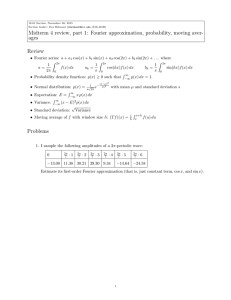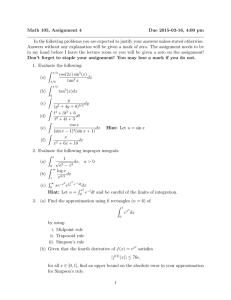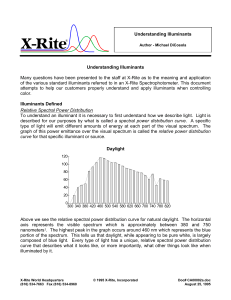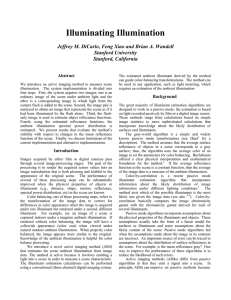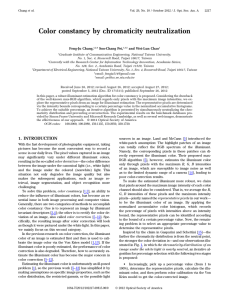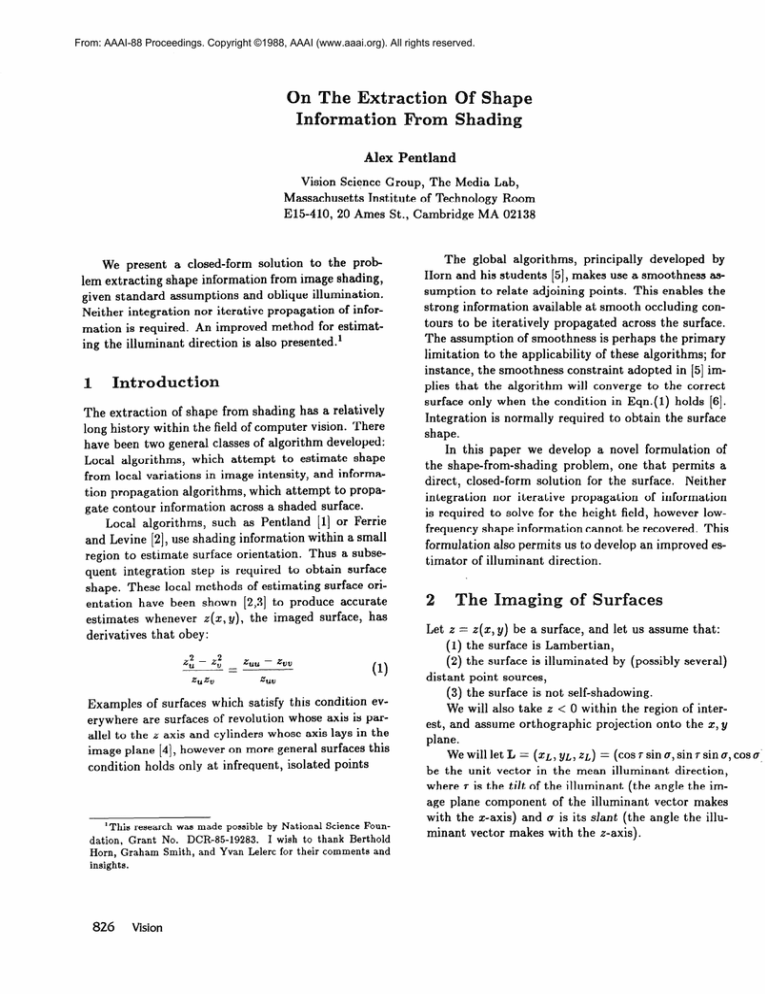
From: AAAI-88 Proceedings. Copyright ©1988, AAAI (www.aaai.org). All rights reserved.
n The Extraction
Information
From
Alex
Pentland
Vision Science Croup, The Media Lab,
Massachusetts
Institute
of Technology Room
E15-410, 20 Ames St., Cambridge
MA 02138
We present a closed-form
solution
to the problem extracting
shape information
from image shading,
given standard assumptions
and oblique illumination.
Neither integration
nor iterative propagation
of information is required.
An improved method for estimating the illuminant
direction is also presented.’
Introduction
The extraction
of shape from shading has a relatively
long history within the field of computer vision. There
have been two general classes of algorithm
developed:
Local algorithms,
which attempt
to estimate shape
from local variations
in image intensity,
and information propagation
algorithms,
which attempt to propagate contour information
across a shaded surface.
Local algorithms,
such as Pentland
[I] or Ferric
and Levine [2], use shading information
within a small
region to estimate surface orientation.
Thus a subsequent integration
step is required to obtain surface
shape. These local methods of estimating
surface orientation
have been shown [2,3] to produce accurate
estimates
whenever
z(z, g), the imaged surface, has
derivatives
that obey:
%; - %,”
------=
2, GJ
&u - &Jv
GA,
(1)
Examples of surfaces which satisfy this condition
everywhere are surfaces of revolution
whose axis is parallel to the z axis and cylinders whose axis lays in the
image plane [4], however on more general surfaces this
condition
holds only at infrequent,
isolated points
‘This research was made possible by National Science Foundation, Grant No. DCR-85-19283.
I wish to thank Berthold
Horn, Graham Smith, and Yvan Lelerc for their comments and
insights.
826
Vision
The global algorithms,
principally
developed
by
Horn and his students [5], makes use a smoothness assumption
to relate adjoining
points. This enables the
strong information
available at smooth occluding contours to be iteratively
propagated
across the surface.
The assumption
of smoothness is perhaps the primary
limitation
to the applicability
of these algorithms;
for
instance, the smoothness constraint
adopted in [5] implies that the algorithm
will converge to the correct
surface only when the condition
in Eqn. (1) holds [6].
Integration
is normally
required to obtain the surface
shape.
In this paper we develop a novel formulation
of
the shape-from-shading
problem, one that permits a
direct, closed-form
solution for the surface.
Neither
integration
nor iterative
propagation
of information
is required to solve for the height field, however lowfrequency shape information
cannot be recovered. This
formulation
also permits us to develop an improved estimator of illuminant
direction.
maging
of Surfaces
Let z = ~(5, y) be a surface, and let us assume that:
(I) the surface is Lambertian,
(2) the surface is illuminated
by (possibly several)
distant point sources,
(3) the surface is not self-shadowing.
We will also take z < 0 within the region of interest, and assume orthographic
projection
onto the x, y
plane.
We will let k = (5~) ye , 2~) = (cos 7 sin 0, sin r sin 0, cos 0:
be the unit vector in the mean illuminant
direction,
where r is the tilt of the illuminant
(the angle the image plane component
of the illuminant
vector makes
with the s-axis) and B is its slant (the angle the illuminant vector makes with the z-axis).
Under these assumptions
tensity I(%, y) will be
pcosrsina
%,
Y) =
the normalized
+ qsinrsino
image in-
+ cost
(2)
(p2 + q2 + 1p2
where m, (f, 8) is the magnitude
at position (f, 0) on
the Fourier plane, and qSlris the phase.
Now since p and q are partial derivatives of a(~, y),
their transforms
F’p and F* are related to FZ in an
elementary fashion. We can write
where
2.1
Linear
In this case, the Fourier
is (ignoring the DC term):
Approximation
If we then take the Taylor series expansion of I( x, y)
about p, q = 0 up through the quadratic
terms, we
obtain
Fz(M) =
2.3
1(x, y) m cos a+p cos r sin a+q sin r sin 0- yqp2+q2)
This expression
gives an excellent
approximation
when
IPI 9 lal < 1.
Under the condition
]p] , IqI < 1 the linear terms
of Eqn. (5) will dominate the power spectrum except
when the average illuminant
is within
roughly f30”
of the viewers’ position.
When either p, q < 1 or the
illumination
direction is roughly perpendicular
to the
line of sight the quadratic terms will be negligible.
We will assume that such is the case in the following analysis2. Thus we will approxi .mate the intensity
function by:
I(z,y)
= cos0 +pcosrsina
Note that this is exactly
2.2
Spectral
reflectance
function
Properties
We will let the complex
+,Y)
the lunar
+ qsinrsina
Fourier
spectrum
F,(f,
8) of’
be
F, (f, e) = r-n, (f, e)ei+“(f,e)
2Note that when these conditions are not true, then the image
gradient direction is approximately parallel to the image-plane
component of the surface orientation (tilt), and the magnitude
of the image intensity gradient is proportional
to the remaining
component of orientation (slant). Thus when our assumptions
are seriously violated, the recovery of surface orientation
may
be accomplished by local analysis of the image gradient field.
transform
27~sin afm=(P,
ecovery
of the image
I
0)ei(d=(f@)+?r/2)
(10)
[cos 8 cos 7 + sin 0 sin 71
of Shape
This spectrum
depends, as expected, upon the illuminant direction
and the surface Z(Z, y). What is remarkable is that given the illuminant
direction we can
recover the surfaces’ Fourier transform directly, except
for an overall scale factor and the low-frequency
terms
which are lost in going from Eqn.(7) to Eqns.(8) and
(9). That is, if we let
then the Fourier
F,(f,Q
transform
of the a surface
is simply
mz(f, ++(W~h/2)
= 27r sin af[cos 0 cos 7 + sin 0 sin 71.
(12)
The ability to directly recover surface shape from
the Fourier components
of the image suggests a theory
of human shape perception.
It is known that the visual systems’ initial cortical processing areas contain
many cells that are tuned to orientation,
spatial frequency and phase. Although
the tuning of these cells
is relatively broad, it is clear that one could produce a
coarse estimate of shape by (I) phase-shifting
the cells’
responses by 7r/2, (2) scale the cells activity
by l/f,
where f is the spatial frequency that the cell is tuned
for, and (3) biasing the cells’ activity to remove coarse
variation
in the distribution
of activity
versus orientation, i.e., to remove the effects of the illumination
direction.
Pentland
827
2.4
Estimating
the Illuminant
Direction.
Pentland
[7] introduced
a method of estimating
illuminant direction
from the distribution
of image derivatives as a function
of image direction.
The method
works by assuming
a statistically
uniform
distribution of surface orientations,
and then performing
a
maximum-likelihood
analysis to estimate
the cosine
variation
in image gradient magnitude
induced by the
directionality
of the illuminant.
In summary,
the result is that:
(xi,
yi)
=
(pTp)-lpT(a,
dI22,
. . ..aJ
(13)
where (zT,, y;) are the unnormalized
x and y components of the illuminant
direction,
p is a 2 x n matrix
of directions
(dxi, dyi) and dli is the mean magnitude
of dI(x, y)/dxi + dI(x, y)/dyi.
Given (xi, yi) we may then find the complete illuminant
direction,
which is simply:
xL = xi/k
YL = YT;lk
ZL =
d
1 - 5; - y;
(14
where
k=j/m
(15)
and E(dl) is the expected
value of dl/dxi + dI/dyi
over all directions
i.
This method has proven to be quite robust [2,3,7],
however the assumption
of uniformly
distributed
surface orientations
is disagreeably
strong.
We can improve this method substantially
by observing
that in
produces
a similar
effect in
Eqn.( 10) th e illuminant
each frequency band. Thus if we make the much weaker
assumption
that the power in a particular
spatial frequency band is uniformly
distributed
over orientation3
then we can use a similar method to estimate the illuminant
direction,
substituting
the magnitude
of the
Fourier components
for magnitude
of the first derivatives. In particular,
Eqn.( 13) becomes
(xi,
YE) =
(PT/m3T(f7%
m2,
.“,
77%).
(16)
where the rni are the magnitude
of the Fourier components within the selected frequency
band in direction
(dx, dy)-
We have applied Eqn.(l2)
to both synthetic
complex surfaces, such as is shown in Figure
30r, more precisely, is not distributed
lated with the illuminant effects
828
Vision
images of
l(a) (this
in a way that is corre-
is a fractal Brownian surface with D = 2.3; max(p, q) w
5.0), as well as to complex
natural
images such as
shown in Figures 2(a) and 3(a). The use of synthetic
imagery is necessary to answer the two important
questions concerning
this method:
One, is the Taylor series
approximation
a good one, and two, is the recovery
stable and accurate?
Figure l(b) s h ows the distribution
of intensity values obtained
when the surface of Figure l(a) is illuminated from L = (1,1, I)/&.
Figure l(c) shows the
distribution
of errors between the full imaging model
and the Taylor .series approximation
using only the
linear terms.
As can be seen, the approximation
is
a good one, even though this surface is often steeply
sloped (i.e., max(p,q)
= 5.0).
Figure l(d) s h ows the surface recovered by use of
Eqn.(l2).
Because the low-frequency
terms and the
overall amplitude
cannot be recovered,
it was necessary to scale the recovered surface to have the same
standard
deviation
as the original
surface before we
could compare the two surfaces.
Figure l(e) shows
the differences
between the original
surface and the
recovered surface. As can be seen, the recovery errors
are uniformly
distributed
across the surface. These errors have a standard
deviation
that is approximately
5% of the standard
deviation
of the original
surface.
It appears that these errors can be attributed
to the
Taylor
expansion
approximation
breaking
down for
steeply-sloped
regions of the surface, i.e., those with
IPI > IQI” 1.
Figure 2(a) shows a high-altitude
image of a mountainous region outside of Phoenix,
Arizona.
This area
has been the subject of intensive study, so that we are
able to compare our shape-from-shading
algorithm
to,
for instance, results obtained using stereopsis.
In particular,
the Defense Mapping
Agency has created a
depth map of this region using their interactive
stereo
system. The stereo depth map they recovered is shown
in Figure 2(b). Such maps are hard to interpret,
so we
created an synthetic image from this stereo depth map
using standard computer graphics techniques.
The image created from the stereo depth map is shown in Figure 2(b). In addition,
Figure 2(d) shows a perspective
view of this stereo depth map.
Figure 2(e) shows the depth map recovered from
the shading information
in Figure 2(a), by use of Eqn.
(12). As part of the recovery process, the illuminant
direction
was estimated
from the Fourier transform
of
the image by use of Eqn.(lG).
To aid in the evaluation
of this shading-derived
depth map, we also created an
[5] Rrooks, M. J., and Horn, B. .I (1985) Shape and
Source from Shading, Ptoc. Int. Joint Conf. op2
Artificial Intelligence, Los Angeles, pp. 932-936.
[6] Smith, G. B., Personal Communication.
[7] Pentland, A. P. (1982) Finding the illuminant
direction Optical Society of America,, Vol. 72, No.
4, 448-455.
[8j
OI
Frankot, R.T., and Chellappa, R., (1987) A Method
For Enforcing Integrability
In Shape From ShadConf. on Coming Algorithms,
Ptoc. First Id.
puter Vision,, pp. 118-127, June g-11, London,
England
’
Figure 2: (a) An image of a mountainous region outside of Phoenix, Arizona,
(b) a depth map of this region obtained from a stereo pair by the Defense
Mapping
Agency, (c) an image created from this stereo depth map, (d) a
from
perspective
view of the stereo depth map, (e) the depth map recovered
shading
information
alone, by use of Eqn. (1 2), (f) an image created from
this shading depth map, and (g) a perwective
view of the depth map derived
from image shading.
c
Figure 1: (a) A fractal Brownian surface, (b) the distribution
of intensities within the image of the surface
in (a), (c) the distribution
of differences between the
image and our linear-term-only
Taylor series approximation, (d)
. the surface recovered from shading (compare to (a)), and (e) the errors in the recovery process.
Figure 3: (a) An image of a woman used in image compression research, (b) a perspective
view of the depth
map recovered from shading information
alone, by use
of Ev.
(lz), ( c ) a close-up of the recovered surface in
the neighborhood
of the womans face; note the presence of eyes, cheek, lips, nostrils, and nose arch, (d) a
shaded, oblique view of the recovered surface.
830
Vision





